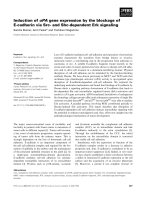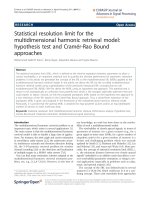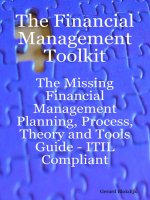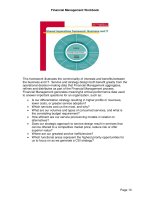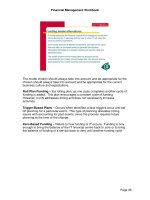The Financial Management Toolkit The Missing Financial Management Planning Process Theory and Tools Guide ITIL Compliant_5 docx
Bạn đang xem bản rút gọn của tài liệu. Xem và tải ngay bản đầy đủ của tài liệu tại đây (93.98 KB, 13 trang )
Financial Management Workbook
Page 52
Financial Management Workbook
Page 53
3.2 Policies, Objectives & Scope
IT Services
Policies, Objectives & Scope
Process: Financial Management
Status: In draft
Under Review
Sent for Approval
Approved
Rejected
Version: <<your version>>
IT Service
Continuity Date:
Financial Management Workbook
Page 54
Policies, Objectives and Scope for Financial Management
The document is not to be considered an extensive statement as its topics have to
be generic enough to suit any reader for any organization.
However, the reader will certainly be reminded of the key topics that have to be
considered.
Policy Statement
A course of action, guiding principle, or procedure considered expedient, prudent,
or advantageous
Use this text box to answer the “SENSE OF URGENCY” question regarding this
process.
Why is effort being put into this process?
Not simply because someone thinks it’s a good idea. That won’t do. The reason has
to be based in business benefits.
You must be able to concisely document the reason behind starting or improving this
process.
Is it because of legal requirements or competitive advantage? Perhaps the business
has suffered major problems or user satisfaction ratings are at the point where
outsourcing is being considered.
A policy statement any bigger than this text box, may be too lengthy to read, lose the
intended audience with detail, not be clearly focused on answering the WHY question
for this process.
The above Policy Statement was;
Prepared by:
On: <<date>>
And accepted by:
On: <<date>>
Refer to Implementation Plan – Project Plan for planning and implementation
guidelines (that includes the Policy, Objectives and Scope statements).
Financial Management Workbook
Page 55
Objectives Statement
Something worked toward or striven for; a goal
Use this text box to answer the “WHERE ARE WE GOING” question regarding this
process.
What will be the end result of this process and how will we know when we have
reached the end result?
Will we know because we will establish a few key metrics or measurements or will it
be a more subjective decision, based on instinct?
A generic sample statement on the “objective” for Financial Management is:
The object of Financial Management is to provide stewardship for the cost
effectiveness of the IT Services and the supporting Infrastructure in such a
manner that IT Services can be budgeted for, accounted for, and charged at a
fair and reasonable price. In addition to this, Financial Management will
perform iterative optimization activities to ensure constant improvements and
alignment.
Note the keywords in the statement. For the statement on Financial
Management they are “cost effective” and “budgeting, accounting and
charging”. These are definite areas that we can set metrics for and therefore
measure progress.
An objective statement any bigger than this text box, may be too lengthy to read,
lose the intended audience with detail, not be clearly focused on answering the
WHERE question for this process.
The above Objective Statement was;
Prepared by:
On: <<date>>
And accepted by:
On: <<date>>
Refer to Objectives and Goals for detailed statement of process
objectives/goals.
Refer to Reports, KPIs and other Metrics for metrics, KPI’s for Financial
Management.
Financial Management Workbook
Page 56
Scope Statement
The area covered by a given activity or subject
The above Scope Statement was;
Prepared by:
On: <<date>>
And accepted by:
On: <<date>>
Use this text box to answer the “WHAT” question regarding this process.
What are the boundaries for this process?
What does the information flow look like into this process and from this process to
other processes and functional areas?
A generic sample statement on the “scope” for Financial Management is:
The Financial Management process will be responsible for budgeting,
accounting and charging involving the following aspects of the IT
Infrastructure:
• Hardware
• Software
• System Software
• Etc
Financial Management will not be responsible for those components that
exist under the banner of Applications Development.
An scope statement any bigger than this text box, may be too lengthy to read, lose
the intended audience with detail, not be clearly focused on answering the WHAT
question for this process.
Financial Management Workbook
Page 57
3.3 Communication Plan
IT Services
Communication Plan
Process: Financial Management
Status: In draft
Under Review
Sent for Approval
Approved
Rejected
Version: <<your version>>
IT Service
Continuity Date:
Financial Management Workbook
Page 58
Communication Plan for Financial Management
The document is not to be considered an extensive statement as its topics
have to be generic enough to suit any reader for any organization.
However, the reader will certainly be reminded of the key topics that have to
be considered.
This document serves as a GUIDE FOR COMMUNICATIONS REQUIRED
for the Financial Management process. This document provides a basis
for completion within your own organization.
This document contains suggestions regarding information to share
with others. The document is deliberately concise and broken into
communication modules. This will allow the reader to pick and choose
information for e-mails, flyers, etc. from one or more modules if and
when appropriate.
This document was;
Prepared by:
On: <<date>>
And accepted by:
On: <<date>>
Financial Management Workbook
Page 59
Initial Communication
Sell the Benefits
First steps in communication require the need to answer the question that most people
(quite rightly) ask when the IT department suggests a new system, a new way of working.
WHY?
It is here that we need to promote and sell the benefits. However, be cautious of using
generic words.
Generic Benefit statements
Specific Organizational example
Improved Customer Service This is important because…
Reduction in the number of Incidents In recent times our incidents within IT
have…
Provides quicker resolution of
Incidents
Apart from the obvious benefits, the IT
department in recent times has…
Improved Organizational learning A recent example of … saw the individual
and others in the company start to…
The above Communication module (or elements of) was/were distributed;
To:
On: <<date>>
By:
On: <<date>>
Financial Management Workbook
Page 60
Financial Management Goal
The Goal of Financial Management
The Goal of Financial Management can be promoted in the following manner.
Official Goal Statement: To provide cost effective stewardship of the IT Assets
through a Financial Management process, providing budgeting, accounting and
charging policies.
• High visibility and wide channels of communication are essential in this process.
Gather specific Financial Requirements from nominated personnel
(Special Tip: Beware of using only Managers to gain information from, as the resistance
factor will be high)
• Oversee the monitoring of process to ensure that the business needs of IT are
not impacted, but taking into account that changes are required to ensure
continued high levels of IT Service Delivery and Support.
• Provide relevant reports to nominated personnel.
(Special Tip: Beware of reporting only to Managers. If you speak to a lot of people
regarding Service Support and Delivery then you need to establish ways to report to
these people the outcomes and progress of the discussions).
Always bear in mind the “so what” factor when discussing areas like goals and
objectives. If you cannot honestly and sensibly answer the question “so what” – then you
are not selling the message in a way that is personal to the listener and gets their “buy-
in”.
The above Financial Management Goals module was distributed;
To:
On: <<date>>
By:
On: <<date>>
Financial Management Workbook
Page 61
Financial Management Activities
Intrusive & Hidden Activities
Information regarding activities was distributed;
To:
On: <<date>>
By:
On: <<date>>
The list of actions in this module will have a direct impact on end users and IT Staff.
They will be curious as to why working with them in this manner, rather than the
historical method of just “doing it”. There could be an element of suspicion and
resistance, so consider different strategies to overcome this initial skepticism.
1. Business Availability Requirements
• Interview and record the needs from the Business
• Capture any critical areas
• Create Financial Management criteria based on the requirements
2. Budgeting
• Perform an assessment of the critical services from a cost perspective
• Put in place communication guidelines for distributing the budget
• Create the IT Budget. Allow accurate scope for predicting costs for the coming
year
3. Accounting
• Create a cost model
• Setup measurements for the cost model based on Service and delivery areas
• Communicate the cost model
4. Charging
• Correct categorization of cost types, elements and units is essential to
determine the right level of charging
• Communicate methods for charging for the IT Services
• Provide a simple, fair and realistic charging policy for IT Services
5. Reporting
• Set appropriate Service Level Achievements
• Agree through Service Level Management the SLA’s for Financial
Management
• Communicate to IT Staff the reason and benefits
• Communicate to business staff the reasons and benefits
Financial Management Workbook
Page 62
Financial Management Planning
Costs
Details regarding the cost of Financial Management were distributed;
To:
On: <<date>>
By:
On: <<date>>
Information relating to costs may be a topic that would be held back from general
communication. Failure to convince people of the benefits will mean total rejection of
associate costs. If required, costs fall under several categories:
• Personnel – Financial Management staff, database management team (Set-up
and ongoing of the availability database)
• Accommodation – Physical location (Set-up and ongoing)
• Software – Tools (Set-up and ongoing)
• Hardware – Infrastructure (Set-up)
• Education – Training (Set-up and ongoing)
• Procedures – external consultants etc (Set-up)
The costs of implementing Financial Management will be outweighed by the benefits. For
example, many organizations have a negative perception of the Financial Management
process as it seems to constantly measure the wrong services. To alleviate this,
customers and end-users need to be constantly informed of the activities and services
being provided through Financial Management. This provides good customer service and
adds a level of comfort to the users in the sense that they can “see” action taking place.
A well run Financial Management process will make major inroads into altering the
perception of the IT Organization.
Financial Management Workbook
Page 63
3.4 Financial Management Process Manager
IT Services
Roles and Responsibilities
Process: Financial Management
Status:
Version: 0.1
Release Date:
Financial Management Workbook
Page 64
Detailed responsibilities of the Financial Management process owner
The Financial Manager…
Description Notes/Comments
1. Will work, at an appropriate level, with representatives of
the organization management and the Finance
Department, to develop the policies of Budgeting, IT
Accounting and Charging.
2. Will implement and maintain the IT Financial
Management Process, covering Budgeting, IT
Accounting and Charging.
3. Will assist in developing account plans and investment
cases for the IT organization and its Customers.
4. Must be capable of managing the IT organization
budget.
5. Will prepare budget forecasts and assist Customers in
preparing IT elements of their budgets.
6. Will be requires to report regularly to IT managers and
Customers on conformance to budgets.
7. Should select suitable tools and processes for gathering
Cost data.
8. Will provide guidance for the development of suitable
cost models.
9. Will seek agreement for suitable IT Accounting policies,
e.g. Depreciation.
10. Will assist in developing cost-benefit cases for IT
investments.
11. Will provide advice to senior management on the cost-
effectiveness of IT solutions.
12. Will identify methods of charging within the
organizations charging policy.
13. Will provide justifications and comparisons for charges.
14. Will ensure that regular bills are prepared for Customers
15. Will prepare a price list of Services, if required.
16. Will provide close support to Service Level
Management, Capacity Management and Business
relationship Management, especially during budget and
Use the
notes/Comments
column in
different ways. If
you are looking
to apply for a
process role,
then you can
check yourself
against the list
(with ticks or look
to update your
resume).
If you are looking
to appoint a
process manager
or promote
someone from
within the
organization you
can make notes
about their
abilities in the
particular area.

